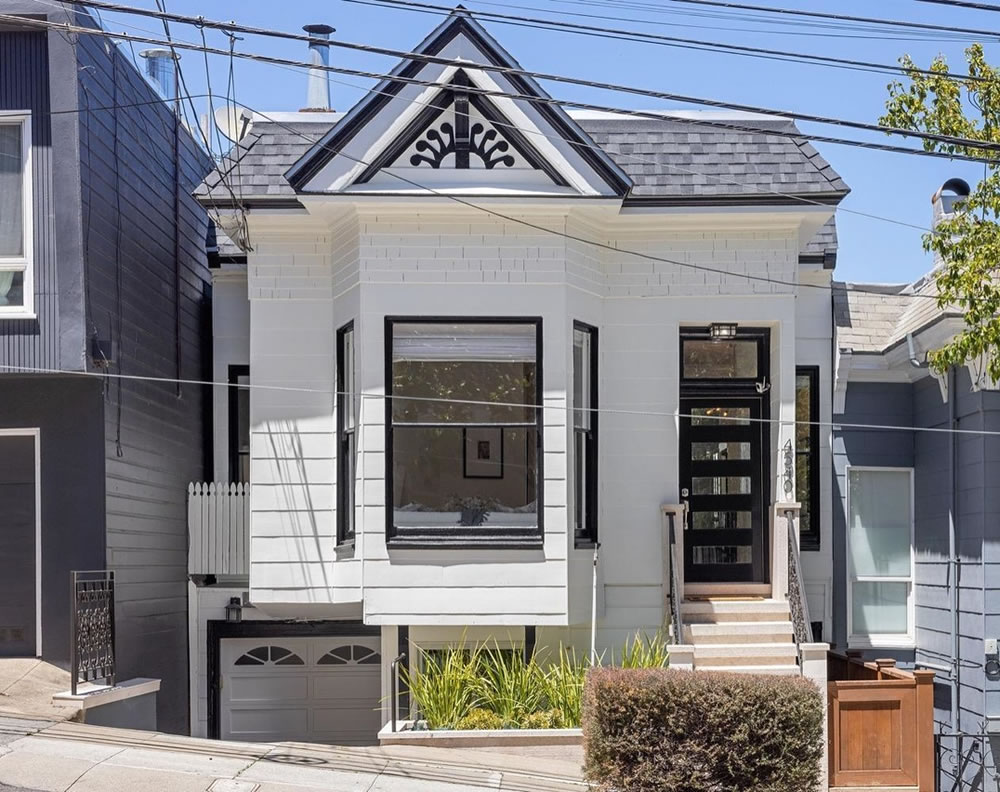Speaking of price reductions in San Francisco and a decline in the price per square foot, the list price for the single-family home at 4540 20th Street, a remodeled home which boasts a “prime Eureka Valley location,” a “chef’s kitchen,” and a private “outdoor oasis”/ rear yard, has been reduced two more times since we featured it [in August] and it’s now priced at $1.999 million having been listed for $2.5 million in July.
While a sale at $1.999 million would be considered to be “at asking” according to all industry stats and aggregate reports, it would be 14 percent below the $2.325 million that was paid for the home in May of 2018, prior to it being further improved.
The sale of 4540 20th Street has now closed escrow with an “over asking” sale price of $2.0 million, which was 14 percent below the $2.325 million that was paid for the home in May of 2018, prior to it being further improved. The widely misrepresented Case-Shiller index for single-family home values in “San Francisco” was up 46 percent over the same period of time.










Some deft cropping in those listing photos, to hide the fact that the building directly behind is taller…
…which of course accounts for the previous higher sales price!
Not only is that driveway especially steep on the downward, it appears that a tall SUV would take-out the corner of the living room. And the work triangle in that “chef’s kitchen” is not well thought-out.
Also, I haven’t seen this mentioned here, but isn’t it long past time for undergrounding electrical lines throughout the city? Great cities don’t have a mess of electrical cables above the streets. Some blocks are undergrounded, others are not. Even in places like Pacific Heights/Russian Hill. Some blocks of Outer Broadway are wire-free. Sea Cliff, too.
..which [ibid]
The need to underground utility lines is one of my biggest peeves about SF, tbh. As you note, any major city should have the lines undergrounded … but that goes double or triple here, with the risks of earthquake and wildfire (which yes, could even happen within SF … if a couple Richmond or Sunset stick-builts caught fire on a windy day, all bets are off…). I guess you could even say it goes quadruple, given that this is a city that tries to pride itself on its natural beauty and aesthetics. Nothing like looking out at a vista of the GG Bridge, or St. Ignatius, or anything else, and having it criss-crossed by umpteen utility lines.
PG&E has claimed it would cost $1M per block to underground the lines – which is ridiculous, at least for the western half of SF which is built on sand.
We undergrounded Waller St & Carmelita & got rid of the hideous rats nest of wires. It makes all the diff.
$2m, tacky exterior shingles. Anything goes here.
Until recently I lived on an Inner Richmond street that had been undergrounded – such a striking difference with immediately adjacent (and otherwise identical) streets that had not been undergrounded. I sometimes wonder if the increases in property value alone wouldn’t justify undergrounding…
If that $1M/block estimate covers the whole project, including the individual feeds to each house, then it sounds like a bargain. About 15 years ago my block had the option to underground. The deal was that PG+E would handle moving the wires into a trench in the street, but each homeowner had to cover the cost of the branch from the street trench to their house. We were given estimates of ~$10K per house for that job which sounds about right.
So connecting ~40 houses per block is about half a million right there. Then there’s the big trench running down the street and associated utility relocations. Another half a million for that sounds realistic.
As I recall, this house was a comp-setter. If you’re a compsetter and an investor, you’re a fool, and if you’re a compsetter but fell in love with what you thought was your forever house, well, you’re still a fool, but a sympathetic one. And I say this as a compsetter myself, saying, heck, I’m going to be here for 30 years! Ah, to be a fool in both love and real estate…30 years can be a long time.
Real estate tautologies 101. In a rising speculative asset market, everything is a ‘compsetter.” Used asset brokers compete for potential customers by flattering and overvaluing the customer’s property, et voila votre nouvelle comp./i>
Everything is not a comp setter in a rising market. This wasn’t even one. Many SFRs sold for far higher $/ft in the area in 2018, they even averaged higher. People make good buys and bad buys in every market. But you wouldn’t grasp that, as you don’t have any experience within the subject matter you so frequently opine, clearly. Quel dommage.
The great thing is the symmetry, with each new lower price becoming a new “comp” on the way down.😊
That’s nothing to do with what I wrote.
Don’t confuse comps with benchmarks or records. In fact, while comps are adjusted for how they actually compare, it would be unusual, not typical, for a recent sale to be excluded from a list of comps when either pricing or valuing another property in the area.
SF is so broken that it won’t tear down a useless little piece of junk from 1900 and replace it with something worth having. Everything about this weird building is just bad, nothing good. It’s a joke with some very questionable cantilevers, obsolete windows in strange arrangements, gas heat and appliances, a wall in the middle of the kitchen counter, no ventilation. Even the 1998 buyer would have been completely justified in demolishing this thing.
They should have just left the interior alone. All of these renovations just make the place less appealing over time. Keep the original fixtures
And yet plenty of people want it and buy it. I myself would much rather have this than some bland box. And the beauty is that if you want a bland box, there are plenty of them on sale elsewhere. But if you tear down existing older homes, they’re gone for good
I think the buyer overpaid. The difficult-to-navigate spiral staircase, the near-unusable (for parking, anyway) garage, the very odd and problematic kitchen… You could do a lot better for your $2 million.